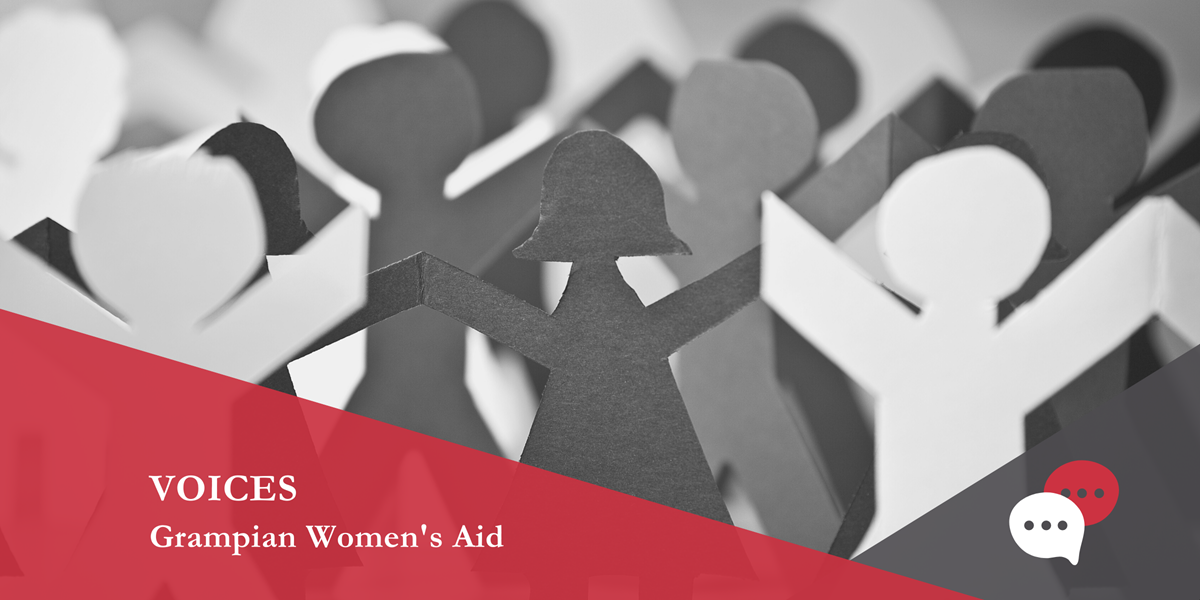What is your organisation working to achieve?
We work within a framework of recognising the gendered nature of domestic abuse, which is routed in gender inequality. We are a feminist organisation and believe that domestic abuse has its root cause in gender equalities. We believe that all women, children and young people have the right to live free from abuse.
We continue to develop our organisation in Aberdeen & Aberdeenshire as the experienced specialist and preferred service provider, for women, children and young people who have experienced domestic abuse.
In order to achieve our aims:
- We are holistic, professional and non-judgemental;
- Our refuge accommodation is managed professionally with high levels of support, safety and security;
- Staff maintain a person-centred approach from the outset, promoting dignity and individuality, providing choice of accommodation where possible;
- We encourage and support individuals to assist themselves so that they feel in control of their lives, giving them a sense of self-worth and ensuring they feel valued in society;
- Privacy will be respected at all times;
- Opportunities will be provided for women and their families to shape the development of the services.
Where are you focusing your support right now?
The area of focus depends on dependants on the stage of the women and children’s journey.
We provide services reflecting the crisis nature of domestic abuse. Where women access our refuge services and support, they often come to us with nothing other than the clothes they are wearing. Through our local partnership, we source food and toiletries packs.
Follow-on support is provided when families and women leave the refuge, aiding with moving in, safety planning and practical support where required and this is provided by our Outreach and Follow-on service.
Not all women will be accommodated in our refuge. We also provide outreach services for women and children who do not want or need refuge accommodation. The level and frequency of support is flexible and tailored to the women's individual needs and risks.
We provide support to Children and Young People, up to the age of 18. We will provide a safe place for the young person to talk on a 1:1 basis and be listened to and believed. We will reflect the way in which children communicate by ensuring that our services are flexible and can be provided online where required.
We also provide a number of opportunities for women to get together through our group work programmes called, ‘Connecting Women’.
"A human rights approach to domestic abuse requires a need-based funding structure for frontline services for women, children and young people experiencing domestic abuse ... we would like to see that all women throughout Scotland have equal access to specialist domestic abuse services wherever they live."
How does poverty and trauma figure in your work?
Domestic abuse is complex trauma because of:
- The cumulative impact of coercive control across a period of time, rather than a single “event”. Crucially, when considering domestic abuse, it should be recognised that the abuse may be historic, recent and/ or current;
- Where it occurs. A perpetrator’s abuse and control often occur in the location—home—that is supposed to provide the greatest sense of stability and safety for adults and children;
- The intimate relationship between the perpetrator and the victim/survivor;
- The perpetrator’s access to the victim/ survivor, which allows them to exert influence and control, like controlling finances or access to family and friends;
- The impact of coercive control on the victim/survivor’s emotional wellbeing, their access to services and the efficacy of those services on the victim/ survivor’s outcomes.
In cases where children and young people are involved, the behaviour of domestic abuse perpetrators is one of the more common sources of traumatic experiences for children and families. Domestic abuse perpetrators often engage in behaviours that are both directed at their adult partner/ former partners and also, directly and indirectly, involve and harm their children.
We review women’s protective capacities which involves a strengths-based assessment of the multiple ways in which they are undertaking actions to keep themselves, and any children they may have, safe in the context of the perpetrator’s behaviour pattern.
Economic abuse can include exerting control over income, spending, bank accounts, bills and borrowing. It can also include controlling access to and use of things like transport and technology, which allow women to work and stay connected, as well as property and daily essentials like food and clothing. It can include destroying items and refusing to contribute to household costs.
This type of abuse is a form of coercive and controlling behaviour. It can continue long after a leaving and can have lifelong effects.
Economic abuse rarely happens in isolation and usually occurs alongside other forms of abuse, including physical, sexual and psychological abuse. 95% of cases of domestic abuse involve economic abuse.
This type of abuse is designed to create economic instability and/or make one partner economically dependent, which limits their freedom. Without access to money and the things that money can buy, it is difficult to leave an abuser and access safety. Someone experiencing this type of abuse can become trapped in a relationship with the abuser, unable to resist the abuser’s control and at risk of further harm. In this way, economic safety underpins physical safety.
How can funders support your work?
A human rights approach to domestic abuse requires a need-based funding structure for frontline services for women, children and young people experiencing domestic abuse.
It is in this unsustainable context that, every day, Women’s Aid workers have to make gruellingly difficult decisions about how to use the too-scarce resources they have to meet rising demand for their services. The impact of COVID-19 continues to be felt through court delays, increase in our referrals and limited funding to cover basic overheads.
What changes would you like to see in your area of focus during the next five years?
We would like to see that all women throughout Scotland have equal access to specialist domestic abuse services wherever they live.
We would like to see all agencies have in-depth training on coercive control so that they have a clear understanding of the impacts on women and children. We would like to see agencies be more domestic abuse informed in their approach to understand the negative impact of perpetrators behaviour and the additional measures forced upon women to take to protect their children and themselves.
We would like women to be able to access legal aid representation which is domestic abuse informed in a timely manner in our area where there is a great shortage. If women can’t afford representation, they shouldn’t be at a disadvantage in the court system.
Finally, more work to eradicate gender inequality needs to continue because until we have gender equality, domestic abuse will continue.
How Grampian Women's Aid work fits with our 2020-2030 strategy
Through our Emotional Wellbeing and Relationships theme, we are interested in funding initiatives that support the emotional and relational needs of people and families affected by or at risk of experiencing poverty and/or trauma. We are particularly interested in work that focuses on activities that empower vulnerable girls and women, including crisis support for those affected by gender-based violence.
We first funded Grampian Women's Aid back in 2016 and we are delighted to be supporting them again under our new strategy. Grampian Women's Aid is led by women for women, who have experience of domestic abuse. The starting point for women is ’what do you want to happen?’, which allows them to work to a model of empowerment, providing choices and options at every step of their support. Being community-led is at the centre of Grampian Women Aid's approach and that is why their work is strongly aligned with our strategy.
Susan Lennartson
Funding Officer


